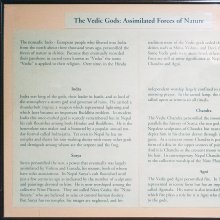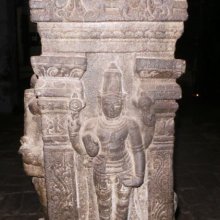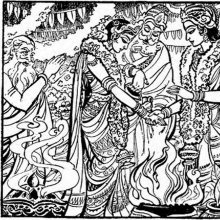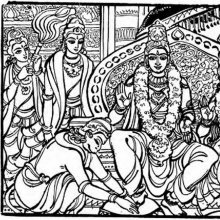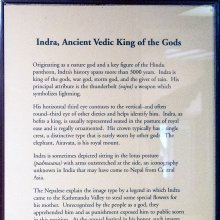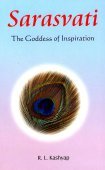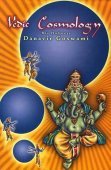Veda, Vedā: 42 definitions
Introduction:
Veda means something in Hinduism, Sanskrit, Jainism, Prakrit, Buddhism, Pali, the history of ancient India, Marathi, Hindi, biology. If you want to know the exact meaning, history, etymology or English translation of this term then check out the descriptions on this page. Add your comment or reference to a book if you want to contribute to this summary article.
Alternative spellings of this word include Ved.
Images (photo gallery)
(+13 more images available)
In Hinduism
Purana and Itihasa (epic history)
Source: archive.org: Puranic Encyclopedia1) Veda (वेद).—The sun of the hermit Ayodhadhaumya. (For further details see under Ayodhadhaumya). (See full article at Story of Veda from the Puranic encyclopaedia by Vettam Mani)
2) Veda (वेद).—Introduction. The root 'Vid' in Sanskrit means 'to know'. The books composed of the knowledge of the Āryans, collected and compiled were called the Vedas.
Source: archive.org: Shiva Purana - English TranslationVeda (वेद) exists in the form syllables of verses and hymns, according to the Śivapurāṇa 2.2.26. Accordingly as Śiva said to Nanda, after the latter cursed Dakṣa (and others):—“[...] O Nandin of great intellect, listen. Do not get angry. You have cursed the Brahmins in vain, erroneously thinking that I have been cursed. Vedas are in the form of syllables of verses and hymns. The Self is established in the Sūkta, whomsoever it may belong to. Hence do not angrily curse the knowers of the Self. The Vedas shall not be cursed by anyone, not even by the evil-minded”.
Source: Kashmiri Overseas Association: The Nīlamata PurāṇaVedas are groups of hymns and chants containing religious and spiritual insights of the ancient sages and seers.
Each Veda consists of four parts:
1) Mantras (or Samhitas): poetic compositions and hymns of supplication and incantation addressed to the deities, the symbolic representations of the Supreme Lord.
2) Brahmanas deal with rules and regulations for proper performance of religious rites, rituals and ceremonies.
3) Aranyakas (as forest books) provide the symbolic and spiritual basis for the Brãhmanas.
4) Upanishads reveal the knowledge about Brahman and are known as Vedãnta, meaning "end of the Vedas." They are the concluding portions of the Vedas.
Whereas the Upanishads represent the essence of the Vedas, the Bhagavad Gita, the most popular scripture of Hindus, contains the essence of the Upanishads. The Vedas reflect the dawn of spiritual insight, the Upanishads and the Bhagavad Gita contain the full splendor of a spiritual vision.
Source: Cologne Digital Sanskrit Dictionaries: The Purana Index1a) Veda (वेद).—The science of Dharma together with the ācāra of those who know it.*
- * Matsya-purāṇa 52. 7; 164. 16.
1b) First came nāda from the Supreme Brahman, then oṅkāra and then mantropaniṣad. Brahmā created Akṣaras, and out of his four mouths appeared the four Vedas, which were taught to his sons. This was handed down by tradition through the ages.1 Originally one, rearranged by Vyāsa into four Samhitās—Ṛg, Yajus, Sāman and Atharvan: distribution among his pupils done by Kṛṣṇadvaipāyana with the help of Paila, Jaimini, Sumantu, and Vaiśampāyana: growth of Śākhās. Lost in a deluge. Then Hari. taught them to Brahmā who taught in his turn to his sons. A three fold division of the Vedas conveys the truth of Brahman and Ātman. In these Hari manifests himself: its metres are Gāyatrī, Uṣṇik and so on.2 Symbolised by Garuḍa: do not shine in Kali.3 Personified: These with Upavedas came to see the Trivikrama form of Hari.4 Learnt by Balarāma and Kṛṣṇa.5 Twenty-eight Vedavyāsas rearranged them in the 28 periods: compiled into four by Parāśara's son, originally one;6 served as vessel for Bṛhaspati to milk the cow-earth;7 restored by Matsya after deluge.8
- 1) Bhāgavata-purāṇa XII. 6. 36-46; III. 12. 36-37; IV. 24. 62; Matsya-purāṇa 2. 13; 3. 2; 4. 7; 285. 8.
- 2) Bhāgavata-purāṇa I. 4. 19-23; XI. 14. 3-6; 21. 35-43; XII. 6. 49-50; Viṣṇu-purāṇa III. 3. 20; 4. 7-9.
- 3) Bhāgavata-purāṇa XII. 11. 19; X. 20. 8.
- 4) Ib. VIII. 21. 2; IX. 22. 37.
- 5) Ib. X. 45. 33.
- 6) Brahmāṇḍa-purāṇa II. 34. 2, 12-30; 35. 116-26; III. 10. 69; IV. 1. 30; 6. 64; Matsya-purāṇa 14. 16.
- 7) Ib. 10. 17.
- 8) Ib. 53. 5; 83. 3; 172. 50.
Veda (वेद) is a name mentioned in the Mahābhārata (cf. ) and represents one of the many proper names used for people and places. Note: The Mahābhārata (mentioning Veda) is a Sanskrit epic poem consisting of 100,000 ślokas (metrical verses) and is over 2000 years old.

The Purana (पुराण, purāṇas) refers to Sanskrit literature preserving ancient India’s vast cultural history, including historical legends, religious ceremonies, various arts and sciences. The eighteen mahapuranas total over 400,000 shlokas (metrical couplets) and date to at least several centuries BCE.
Natyashastra (theatrics and dramaturgy)
Source: Wisdom Library: Nāṭya-śāstraVeda (लोक) refers to the “revealed text”. It is one of the three means of valid knowledge (pramāṇa). According to the Nāṭyaśāstra 25.120-121, “Drama (nāṭya) composed of veda and adhyātma is couched in words and metres, is testified by loka (actual life)”.

Natyashastra (नाट्यशास्त्र, nāṭyaśāstra) refers to both the ancient Indian tradition (shastra) of performing arts, (natya—theatrics, drama, dance, music), as well as the name of a Sanskrit work dealing with these subjects. It also teaches the rules for composing Dramatic plays (nataka), construction and performance of Theater, and Poetic works (kavya).
Mīmāṃsā (school of philosophy)
Source: Srimatham: Mīmāṃsa: The Study of Hindu ExegesisVeda (वेद).—The Veda does not necessarily contain history or science. The Veda is claimed to be ‘eternal’ in that the truths propounded in it have a perennial validity for all time. The Veda can thus, by definition neither deal with temporal evanescent events, nor can they provide empirical facts or scientific generalizations based on those events. The ethics taught in the Veda are the factors by which we advance spiritually, they are injunctions only, which can neither be proved nor disproved by logic.
Vedic literature is divided into four sections Saṃhita, Brāhmaṇa, Āraṇyaka and Upaniṣads. The Saṃhitas are the core texts which consist of the revelations of the great sages (ṛṣis). They are presented in the form of hymns and poems (su-uktas = well said). The Brāhmaṇas and Āraṇyakas are ritual texts based upon the practical application and usage of the Saṃhita portion in rituals (yajñas) and the Upaniṣads are the philosophical texts which concern us the most.
The is a variety of opinions among preceptors as to what exactly constitute Veda;
- That by which the means of obtaining the transcendental goal of life is known.
- The Veda is that which makes known the transcendental means of obtaining the desirable and avoiding the undesirable.
- The Vedas are the truly authoritative and valid texts which have no author and which propound Dharma and Brahman.

Mimamsa (मीमांसा, mīmāṃsā) refers to one of the six orthodox Hindu schools of philosophy, emphasizing the nature of dharma and the philosophy of language. The literature in this school is also known for its in-depth study of ritual actions and social duties.
Nyaya (school of philosophy)
Source: Srimatham: Mīmāṃsa: The Study of Hindu Exegesis (nyāya)Veda (वेद).—The Veda, for Nyāya, is inerrant and free from contradictions. If it were not the authentic Scripture, it could have neither established the institution of four castes and four stages of life, nor would it have been acceptable to generations of good men from immemorial times till now. Reasoning cannot give the entire truth; it cannot establish what is 'good' or 'bad'. Any inference opposed to perception or the Scripture is only an apparent inference. In the realm of Dharma, Nyāya holds, reason is useful only in protecting the truth revealed by Scripture from heresies, and has no positive role

Nyaya (न्याय, nyaya) refers to a school of Hindu philosophy (astika), drawing its subject-matter from the Upanishads. The Nyaya philosophy is known for its theories on logic, methodology and epistemology, however, it is closely related with Vaisheshika in terms of metaphysics.
Samkhya (school of philosophy)
Source: Srimatham: Mīmāṃsa: The Study of Hindu Exegesis (sāṃkhya)Veda (वेद).—According to Kapila, the Veda is neither eternal, nor a product. No one could have produced it: for a person in bondage, lacking omniscience, could not have authored it, while a 'liberated’ person would not have a motive to do anything. The Veda itself says it is a product; so it cannot be eternal. The Veda came into existence spontaneously, like the grass and trees in a forest. Its validity is intrinsic and self-proved.

Samkhya (सांख्य, Sāṃkhya) is a dualistic school of Hindu philosophy (astika) and is closeley related to the Yoga school. Samkhya philosophy accepts three pramanas (‘proofs’) only as valid means of gaining knowledge. Another important concept is their theory of evolution, revolving around prakriti (matter) and purusha (consciousness).
Vaishnavism (Vaishava dharma)
Source: Prabhupada Books: Sri Caitanya CaritamrtaVeda (वेद).—The Vedas are considered to have been spoken by the Supreme Lord. They were first realized by Brahmā, who is the first created being within the universe (tene brahma hṛdā ya ādi-kavaye). Our process is to receive knowledge through the paramparā system, from Kṛṣṇa to Brahmā, to Nārada, Vyāsa, Śrī Caitanya Mahāprabhu and the six Gosvāmīs. By disciplic succession, Lord Brahmā was enlightened from within by the original person, Kṛṣṇa.
Source: Pure Bhakti: Bhagavad-gita (4th edition)Veda (वेद) refers to “knowledge, or the four primary books of knowledge compiled by Śrīla Vyāsadeva: the Ṛg Veda, Sāma Veda, Atharva Veda and Yajur Veda”. (cf. Glossary page from Śrīmad-Bhagavad-Gītā).
Source: Pure Bhakti: Bhajana-rahasya - 2nd EditionVeda (वेद) refers to:—The four primary books of knowledge compiled by Śrīla Vyāsadeva, namely, the Ṛg Veda, Sāma Veda, Atharva Veda and Yajur Veda. (cf. Glossary page from Bhajana-Rahasya).
Source: Pure Bhakti: Brhad BhagavatamrtamVeda (वेद) refers to:—Knowledge; the four primary books of knowledge compiled by Śrīla Vyāsadeva: the Ṛg Veda, Sāma Veda, Atharva Veda, and Yajur Veda. (cf. Glossary page from Śrī Bṛhad-bhāgavatāmṛta).

Vaishnava (वैष्णव, vaiṣṇava) or vaishnavism (vaiṣṇavism) represents a tradition of Hinduism worshipping Vishnu as the supreme Lord. Similar to the Shaktism and Shaivism traditions, Vaishnavism also developed as an individual movement, famous for its exposition of the dashavatara (‘ten avatars of Vishnu’).
Vyakarana (Sanskrit grammar)
Source: Wikisource: A dictionary of Sanskrit grammarVeda (वेद).—Language of the Vedic Literature as contrasted with the term लोकः (lokaḥ); cf. नैव लोके न च वेदे अकारो विवृतोस्ति (naiva loke na ca vede akāro vivṛtosti) M. Bh. on Mahesvara Sutra; cf. also रक्षार्थं वेदानामध्येयं व्याकरणम् (rakṣārthaṃ vedānāmadhyeyaṃ vyākaraṇam) M. Bh.Ahnika 1. The term वैदिक (vaidika) referring to words found in Vedic language is also frequently used in the Mahabhasya. Panini, however, has used the term छन्दस्, मन्त्र (chandas, mantra) and निगम (nigama), and not वेद (veda), out of which the first term छन्दस् (chandas) is often used; cf. बहुलं छन्दसि (bahulaṃ chandasi) P. II. 4.39, 76; III, 2.88; V. 2.122; or छन्दसि च (chandasi ca) P. V. 1.67, V. 4.142, VI. 3.126. VI. l.34, VII. 1.8, etc.

Vyakarana (व्याकरण, vyākaraṇa) refers to Sanskrit grammar and represents one of the six additional sciences (vedanga) to be studied along with the Vedas. Vyakarana concerns itself with the rules of Sanskrit grammar and linguistic analysis in order to establish the correct context of words and sentences.
Dharmashastra (religious law)
Source: Knowledge Traditions & Practices of India: Education: Systems & PracticesVeda (वेद) refers to a category of Apaurūṣeya texts, or “disciplines dealing with knowledge not contingent on individuals” (a type of Śāstra or ‘learned discipline’), all part of the ancient Indian education system, which aimed at both the inner and the outer dimension of a person.The Vedas also includes the Upaniṣads.
Source: Shodhganga: The saurapurana - a critical study (dharma)Veda (वेद) is said to be the “eternal eyes of all beings”, according to the 10th century Saurapurāṇa: one of the various Upapurāṇas depicting Śaivism.—The Purāṇas accept the authority of the Vedas and all dharmaśāstras are also rooted in the Vedas. The Saurapurāṇa admits the authority of the Vedas. They are adored by the people. The Brāhmaṇas perform karma on the basis of the Vedas. It is stated that if some body does any karma surpassing the Vedas, his karma becomes futile. Disregard to the Vedas brings hell to the persons. The Vedas are the most beneficial in the three worlds. The Vedas are said to be the eternal eyes of all beings. Veda brings happiness to all persons.
A person should study the Vedas from the Guru and after completion of study, he should be householder after giving dakṣiṇā to the Guru. The Saurapurāṇa lays emphasis on the Vedic mantra Gāyatrī. [...] The four Vedas are the feet of Gāyatrī and Brahmā, Viṣṇu, Rudra and Īśa are the presiding deities of the feet.

Dharmashastra (धर्मशास्त्र, dharmaśāstra) contains the instructions (shastra) regarding religious conduct of livelihood (dharma), ceremonies, jurisprudence (study of law) and more. It is categorized as smriti, an important and authoritative selection of books dealing with the Hindu lifestyle.
Pancaratra (worship of Nārāyaṇa)
Source: University of Vienna: Sudarśana's Worship at the Royal Court According to the AhirbudhnyasaṃhitāVeda (वेद) refers to the “revealed knowledge”, according to the Ahirbudhnyasaṃhitā, belonging to the Pāñcarātra tradition which deals with theology, rituals, iconography, narrative mythology and others.—Accordingly, “[...] Out of [his own] head indeed has God, the Lord, created the King in ancient times. Therefore does he have his head anointed and stands above all beings. The King is praised in Revealed Knowledge and Systematized Bodies of Knowledge (veda—vedaśāstreṣu) as a double Brāhmaṇa (i.e. as worth twice as much as a Brāhmaṇa). If one is hostile to him out of delusion, that fool is hostile to Hari [himself]”.

Pancaratra (पाञ्चरात्र, pāñcarātra) represents a tradition of Hinduism where Narayana is revered and worshipped. Closeley related to Vaishnavism, the Pancaratra literature includes various Agamas and tantras incorporating many Vaishnava philosophies.
Ganitashastra (Mathematics and Algebra)
Source: archive.org: Hindu MathematicsVeda (वेद) represents the number 4 (four) in the “word-numeral system” (bhūtasaṃkhyā), which was used in Sanskrit texts dealing with astronomy, mathematics, metrics, as well as in the dates of inscriptions and manuscripts in ancient Indian literature.—A system of expressing numbers by means of words arranged as in the place-value notation was developed and perfected in India in the early centuries of the Christian era. In this system the numerals [e.g., 4—veda] are expressed by names of things, beings or concepts, which, naturally or in accordance with the teaching of the Śāstras, connote numbers.

Ganitashastra (शिल्पशास्त्र, gaṇitaśāstra) refers to the ancient Indian science of mathematics, algebra, number theory, arithmetic, etc. Closely allied with astronomy, both were commonly taught and studied in universities, even since the 1st millennium BCE. Ganita-shastra also includes ritualistic math-books such as the Shulba-sutras.
Ayurveda (science of life)
Toxicology (Study and Treatment of poison)
Source: Shodhganga: Kasyapa Samhita—Text on Visha ChikitsaVeda (वेद) refers to the fountainhead of all our knowledge and culture.—It is but inevitable that Toxicology, variously reckoned as Agadatantra, or Sarpavidyā or Viṣavidyā—is also sourced from the Ṛgveda and Atharva veda. Snakes, in general are venomous and hence a study of sarpas presupposes a knowledge of viṣavidyā—also known as gāruḍīvidyā. [...] Kāśyapa, the legendary sage was an accomplished scholar in the Vedas, Āyurveda, Dharmaśāstra, Śilpaśāstra, Kṛṣivijñāna (Agricultural Science), Saṅgītaṣāstra and so on. [...] Kāśyapa and his geneology are mentioned repeatedly in the Vedas, Purāṇas and epics, many of which even seem to be allegorical.

Āyurveda (आयुर्वेद, ayurveda) is a branch of Indian science dealing with medicine, herbalism, taxology, anatomy, surgery, alchemy and related topics. Traditional practice of Āyurveda in ancient India dates back to at least the first millenium BC. Literature is commonly written in Sanskrit using various poetic metres.
General definition (in Hinduism)
Source: archive.org: Vedic index of Names and SubjectsVeda (वेद) in the Atharvaveda and later denotes ‘sacred lore’. In the plural it more definitely refers to the Vedas of the Ṛc, Yajus, and Sāman. Cf. Vidyā.
Source: WikiPedia: Hinduism1) Veda (वेद): Collectively refers to a corpus of ancient Indo-Aryan religious literature that are considered by adherents of Hinduism to be revealed knowledge. Many Hindus believe the Vedas existed since the beginning of creation.
2) The Vedas are identified with Brahman, the universal principle (ŚBM 10.1.1.8, 10.2.4.6). Vāc "speech" is called the "mother of the Vedas" (ŚBM 6.5.3.4, 10.5.5.1). The knowledge of the Vedas is endless, compared to them, human knowledge is like mere handfuls of dirt (TB 3.10.11.3-5). The universe itself was originally encapsulated in the three Vedas (ŚBM 10.4.2.22 has Prajapati reflecting that "truly, all beings are in the triple Veda").
Source: Hindupedia: The Hindu EncyclopediaVeda is the highest authority in Hindu knowledge system and the authority of all other scriptures are based on the authority of the Veda. Vedas are four - Rig, Yajur, Sama and Atharva. Rigveda contains prayers to Gods (Riks are the mantras). Yajurveda has methods to use Riks for sacrifices (Yajus-Yajna). Sama Veda introduces musical notes. Atharva Veda gives ways to make life successful, and contains methods to fulfill what can be called material aspirations.
Each Veda has three sections - Samhita, Brahmana and Aranyaka.
1) Samhita has prayers or Suktas. Brahmana has sacrificial methods.
2) Aranyaka has Mantras and methods that are practiced in the forests (that is, not for grhasthas).
3) Upanishads normally appear in the last part of Aranyaka and deal with spiritual philosophy. Some Upanishads are exceptions and appear in Samhita and Brahmana too. Thus Upanishad, as it appears in the last part of the Veda, is called Vedanta. There are 108 Upanishads and 10 of them are famous. Since Upanishads mostly philosophical they are found in prose. But there are Upanishads like Taittireeya and Ganapathi Atharva Seersha that have svara.
Source: Shodhganga: Kasyapa Samhita—Text on Visha Chikitsa (h)Veda (वेद) refers to the world’s oldest records which have chronicled the manifold rules of religion followed by people in ancient times. The word “vid” from which “veda” is derived, means “to know”—the means of Tattva or the Ultimate Reality. Concomitant with the Vedas is the existence of another line of thought, that is the Āgama or Nigama. [...] While the Vedas are considered as the breath of the Almighty (niśvāsa-rūpa), the Āgamas are His words (vāg-rūpa).
In Jainism
General definition (in Jainism)
Source: academia.edu: Tessitori Collection IVeda (वेद) refers to the “sex” (of the Gods, Humans, Animals, etc.), as defined in the “Arhadvijñaptirūpā Vicāraṣaṭtriṃśikā” by Gajasāra, which is included in the collection of manuscripts at the ‘Vincenzo Joppi’ library, collected by Luigi Pio Tessitori during his visit to Rajasthan between 1914 and 1919.—The Vicāraṣaṭtriṃśikā (in Prakrit) was first presented in tabular form (yantra) according to the commentators, and then put in the form of a text. [...] Each category is then examined through twenty-four parameters [e.g., sex (veda)].

Jainism is an Indian religion of Dharma whose doctrine revolves around harmlessness (ahimsa) towards every living being. The two major branches (Digambara and Svetambara) of Jainism stimulate self-control (or, shramana, ‘self-reliance’) and spiritual development through a path of peace for the soul to progess to the ultimate goal.
India history and geography
Source: Cologne Digital Sanskrit Dictionaries: Indian Epigraphical GlossaryVeda.—(IE 7-1-2), ‘four’ (the four Vedas being Ṛk, Yajus, Sāman and Atharvan); rarely used to indicate ‘three’ (cf. trayī) in late records (IE 7-1-2; IA 9). Note: veda is defined in the “Indian epigraphical glossary” as it can be found on ancient inscriptions commonly written in Sanskrit, Prakrit or Dravidian languages.

The history of India traces the identification of countries, villages, towns and other regions of India, as well as mythology, zoology, royal dynasties, rulers, tribes, local festivities and traditions and regional languages. Ancient India enjoyed religious freedom and encourages the path of Dharma, a concept common to Buddhism, Hinduism, and Jainism.
Biology (plants and animals)
Source: Google Books: CRC World Dictionary (Regional names)Veda in India is the name of a plant defined with Salvadora persica in various botanical sources. This page contains potential references in Ayurveda, modern medicine, and other folk traditions or local practices It has the synonym Salvadora crassinervia Hochst. ex T. Anderson (among others).
Example references for further research on medicinal uses or toxicity (see latin names for full list):
· Cytologia (1988)
· Species Plantarum (1753)
· Nomenclator Botanicus (1840)
· J. Proc. Linn. Soc., Bot. (1860)
· Nat. Prod. Res. (2003)
If you are looking for specific details regarding Veda, for example extract dosage, chemical composition, pregnancy safety, diet and recipes, side effects, health benefits, have a look at these references.

This sections includes definitions from the five kingdoms of living things: Animals, Plants, Fungi, Protists and Monera. It will include both the official binomial nomenclature (scientific names usually in Latin) as well as regional spellings and variants.
Languages of India and abroad
Pali-English dictionary
Source: BuddhaSasana: Concise Pali-English Dictionaryveda : (m.) religious feeling; knowledge; the brahmanic canon of authorised religious teaching.
Source: Sutta: The Pali Text Society's Pali-English DictionaryVeda, (fr. vid, or more specifically ved as P. root) 1. (cp. vediyati & vedanā) (joyful) feeling, religious feeling, enthusiasm, awe, emotion, excitement (something like saṃvega) D. II, 210 (°paṭilābha+somanassa-paṭilābha); M. I, 465 (uḷāra); Sn. 1027 (=pīti SnA 585); J. II, 336; III, 266. attha-veda+dhamma-veda enthusiasm for the truth (for the letter & the spirit) of Buddha’s teaching M. I, 37; A. V, 329 sq. 333, 349, 352; veda here interpreted as “somanassaṃ” at MA. I, 173.—See also cpd. °jāta.—2. (cp. vedeti & vijjā) (higher) knowledge (as “Buddhist” antithesis to the authority of the “Veda”), insight, revelation, wisdom: that which Bdhgh at MA. I, 173 defines with “ñāṇa, ” and illustrates with vedagū of Sn. 1059; or refers to at DA. I, 139 with definition “vidanti etenā ti vedo. ” Thus at Sn. 529 & 792 (=vedā vuccanti catūsu maggesu ñāṇaṃ paññā Nd1 93), cp. SnA 403.—As adj. veda Ep. of the Buddha “the knower” or the possessor of revelation, at M. I, 386. See also vedagū.—3. the Veda(s), the brahmanic canon of authorized religious teaching (revelation) & practice; otherwise given as “gantha” i.e. “text” at MA. I, 173, & illustrated with “tiṇṇaṃ vedānaṃ pāragū. ” The latter formula is frequent in stock phrase describing the accomplishments of a Brahmin, e.g. at D. I, 88; M. II, 133; Sn. 1019; A. I, 163; DhA. III, 361. In the older texts only the 3 Vedas (irubbeda=Rg; yaju° & sāma°) are referred to, whereas later (in the Commentaries) we find the 4 mentioned (athabbana added), e.g. the three at S. IV, 118; J. I, 168; II, 47; III, 537; Miln. 10; Vism. 384; the four at DA. I, 247; Miln. 178.—Unspecified (sg.): SnA 462. As adj. veda “knowing the Vedas” SnA 463 (ti°), cp. tevijja.—The Vedas in this connection are not often mentioned, they are almost identical with the Mantras (see manta) and are often (in Com.) mentioned either jointly with manta or promiscuously, e.g. Pv. II, 613 (the Vedas with the 6 aṅgas, i.e. vedāṅgas, called manta); SnA 293 (manta-pāragū+veda-pāragū), 322, 448.

Pali is the language of the Tipiṭaka, which is the sacred canon of Theravāda Buddhism and contains much of the Buddha’s speech. Closeley related to Sanskrit, both languages are used interchangeably between religions.
Marathi-English dictionary
Source: DDSA: The Molesworth Marathi and English Dictionaryvēḍa (वेड).—f A web woven with the fibrous roots of the wheat-stalks as they lie in the maṇḍaḷī or rick; to prevent the sheaves from being pulled out by thieves. 2 n f A ring in general (for a finger or a toe).
--- OR ---
vēḍa (वेड).—f (Properly īḍa) Lime-tree, Citrus lemonum. 2 n also vēḍalimbūṃ or -nimbūṃ n A lime.
--- OR ---
vēḍa (वेड).—n (viḍa S To rage, chafe, fume.) Madness. 2 Foolishness or folly : also a foolish act. 3 fig. A violent and unreasonable passion or desire after. vēḍa kāḍhaṇēṃ To bring on madness. 2 To take the conceit (wild haughtiness) out of. vēḍa ghēūna pēḍa- gāṃvāsa jāṇēṃ To feign madness or idiocy in order to accomplish some crafty purpose. vēḍa pikaṇēṃ, vēḍācā pāūsa paḍaṇēṃ Phrases expressive of wild excesses, riotous and extravagant proceedings, any general tumultuousness or uproar. vēḍa bharaṇēṃ in. con. To get mad. vēḍa bharaṇēṃ or bharaviṇēṃ To drive one mad or furious; to vex to madness. vēḍa lāvaṇēṃ To bring madness upon. Ex. vēḍa lāvalēṃ bhratārālā || nāhīṃ rāhilā laukika ||. vēḍīcēṃ sōṅga ghēṇēṃ To feign madness. Used esp. of a debtor feigning insolvency, of a man of service or work feigning incompetency &c.
--- OR ---
vēḍā (वेडा).—a (vēḍa) Mad. 2 Doltish, foolish, idiotlike. 3 Wild, frantic, incoherent--speech, acts. 4 with g. of o. Enamoured of, transported with, mad after.
--- OR ---
vēda (वेद).—m (S) A Veda, the generic term for the sacred writings of the Hindus; supposed to have been revealed by Brahma, and, after being preserved by tradition for a considerable period, to have been arranged in their present form by Vyasa. The principal Vedas are three, the ṛc, yajusa, & sāma; to these a fourth, the atharva, is added; and the Itihas and Puran̤s, or ancient history and mythology, are sometimes considered as a fifth. vēda pl haraṇēṃ g. of s. To be foiled in all one's schemings and plannings and clever contrivings; to be at one's wits' end. A phrase agreeing with tantra haraṇēṃ or tantra mantra haraṇēṃ.
Source: DDSA: The Aryabhusan school dictionary, Marathi-Englishvēḍa (वेड).—n Madness; folly. n f A ring. vēḍa lāvaṇēṃ Bring madness upon. vēḍīcēṃ sōṅga ghēṇēṃ Feign madness.
--- OR ---
vēḍā (वेडा).—a Mad; foolish. Frantic. Enamour- ed of.
--- OR ---
vēda (वेद).—m The Hindu Scriptures.
Marathi is an Indo-European language having over 70 million native speakers people in (predominantly) Maharashtra India. Marathi, like many other Indo-Aryan languages, evolved from early forms of Prakrit, which itself is a subset of Sanskrit, one of the most ancient languages of the world.
Sanskrit dictionary
Source: DDSA: The practical Sanskrit-English dictionaryVeḍa (वेड).—A kind of sandal.
Derivable forms: veḍam (वेडम्).
--- OR ---
Veḍā (वेडा).—A boat. (See beḍā).
--- OR ---
Veda (वेद).—[vid-ac ghañ vā]
1) Knowledge.
2) Sacred knowledge, holy learning, the scripture of the Hindus. (Originally there were only three Vedas :ṛgveda, yajurveda and sāmaveda, which are collectively called trayī 'the sacred triad'; but a fourth, the atharvaveda, was subsequently added to them. Each of the Vedas had two distinct parts, the Mantra or Samhitā and Brāhmaṇa. According to the strict orthodox faith of the Hindus the Vedas are a-pauruṣeya, 'not human compositions', being supposed to have been directly revealed by the Supreme Being, Brahman, and are called Śruti' i. e. 'what is heard or revealed', as distinguished from 'Smṛti', i. e. 'what is remembered or is the work of human origin'; see śruti, smṛti also; and the several sages, to whom the hymns of the Vedas are ascribed, are, therefore, called draṣṭāraḥ 'seers', and not kartāraḥ or sṛṣṭāraḥ 'composers'.)
3) A bundle of Kuśa grass; पद्माक्षमालामुत जन्तुमार्जनं वेदं च साक्षात्तप एव रूपिणौ (padmākṣamālāmuta jantumārjanaṃ vedaṃ ca sākṣāttapa eva rūpiṇau) Bhāg. 12.8.34; Manusmṛti 4.36.
4) Name of Viṣṇu.
5) A part of a sacrifice (yajñāṃga).
6) Exposition, comment, gloss.
7) A metre.
8) Acquisition, gain, wealth (Ved).
9) Name of the number 'four'.
1) The ritual (vedayatīti vedo vidhiḥ); Karma-kāṇda; वेदवादस्य विज्ञानं सत्याभासमिवानृतम् (vedavādasya vijñānaṃ satyābhāsamivānṛtam) Mahābhārata (Bombay) 12.1. 2 (see Nīlakaṇtha's commentary).
11) Smṛti literature; आम्नायेभ्यः पुनर्वेदाः प्रसृताः सर्वतोमुखाः (āmnāyebhyaḥ punarvedāḥ prasṛtāḥ sarvatomukhāḥ) Mahābhārata (Bombay) 12.26.9.
Derivable forms: vedaḥ (वेदः).
Source: Cologne Digital Sanskrit Dictionaries: Shabda-Sagara Sanskrit-English DictionaryVeḍā (वेडा).—f.
(-ḍā) A boat. E. viḍ to curse, aff. ac, and ṭāp added.
--- OR ---
Veda (वेद).—m.
(-daḥ) 1. A Veda, the generic term for the sacred writings or scripture of the Hindus; supposed to have been revealed by Brahma, and after being preserved by tradition for a considerable period, to have been arranged in the present from by Vyasa; the principle Vedas are three in number, the Rich, Yajus, and Sama, to which a fourth, the Atharva, is usually added, and the Itihasa and Puranas, or ancient history and mythology, are sometimes considered as a fifth. The Vedas are regarded as a direct revelation from the deity and are called Shruti, (what is heard,) to distinguish them from Smriti or sacred lore of human origin; the several sages to whom verses or hymns of the Vedas are ascribed are regarded as seers. (draṣṭāraḥ) and not as composers, (sraṣṭāraḥ) 2. Metre. 3. Gloss, comment, explanation. 4. Knowledge. 5. Vishnu. E. vid to know, (duty and religion from it,) aff. ghañ .
Source: Cologne Digital Sanskrit Dictionaries: Benfey Sanskrit-English DictionaryVeḍā (वेडा).—f. A boat.
--- OR ---
Veda (वेद).—i. e. vid + a, m. 1. Knowledge. 2. The generic name for the sacred writings of the Hindus, especially for the four collections called Ṛgveda, i. e. Ṛc-, Yajurveda, i. e. Yajus-, Sāmaveda, i. e. Sāman-, and Atharvaveda, i. e. Atharvan-, [Mānavadharmaśāstra] 1, 21; [Pañcatantra] iii. [distich] 64; 205 (pl.); Mahābhārata in
Veda (वेद).—1. [masculine] knowledge, [especially] sacred knowledge, the (triple) Veda.
--- OR ---
Veda (वेद).—2. [masculine] finding, obtaining.
--- OR ---
Veda (वेद).—3. [masculine] a tuft of strong grass used to sweep, to kindle fire, etc.
--- OR ---
Veda (वेद).—4. [masculine] [Name] of [several] men.
Source: Cologne Digital Sanskrit Dictionaries: Aufrecht Catalogus CatalogorumVeda (वेद) as mentioned in Aufrecht’s Catalogus Catalogorum:—Saṃgītapuṣpāñjali. Saṃgītamakaranda, written for Makaranda Śrīsāha.
Source: Cologne Digital Sanskrit Dictionaries: Monier-Williams Sanskrit-English Dictionary1) Veḍa (वेड):—n. a kind of coarse sandal (= sāndra-vicchinna-candana), [cf. Lexicographers, esp. such as amarasiṃha, halāyudha, hemacandra, etc.]
2) Veḍā (वेडा):—[from veḍa] f. (also written beḍā) a boat, [cf. Lexicographers, esp. such as amarasiṃha, halāyudha, hemacandra, etc.] (cf. veṭī).
3) Veda (वेद):—1. veda m. ([from] √1. vid q.v.) knowledge, true or sacred knowledge or lore, knowledge of ritual, [Ṛg-veda; Aitareya-brāhmaṇa]
4) Name of certain celebrated works which constitute the basis of the first period of the Hindū religion (these works were primarily three, viz. 1. the Ṛg-veda, 2. the Yajur-veda [of which there are, however, two divisions See taittirīya-saṃhitā, vājasaneyi-saṃhitā], 3. the Sāma-veda ; these three works are sometimes called collectively trayī, ‘the triple Vidyā’ or ‘threefold knowledge’, but the Ṛg-veda is really the only original work of the three, and much the most ancient [the oldest of its hymns being assigned by some who rely on certain astronomical calculations to a period between 4000 and 2500 B.C., before the settlement of the Āryans in India; and by others who adopt a different reckoning to a period between 1400 and 1000 B.C., when the Āryans had settled down in the Panjāb]; subsequently a fourth Veda was added, called the Atharva-veda, which was probably not completely accepted till after Manu, as his law-book often speaks of the three Vedas-calling them trayam brahma sanātanam, ‘the triple eternal Veda’, but only once [xi, 33] mentions the revelation made to Atharvan and Aṅgiras, without, however, calling it by the later name of Atharva-veda; each of the four Vedas has two distinct parts, viz. 1. Mantra, id est. words of prayer and adoration often addressed either to fire or to some form of the sun or to some form of the air, sky, wind etc., and praying for health, wealth, long life, cattle, offspring, victory, and even forgiveness of sins, and 2. Brāhmaṇa, consisting of Vidhi and Artha-vāda, id est. directions for the detail of the ceremonies at which the Mantras were to be used and explanations of the legends etc. connected with the Mantras [see brāhmaṇa, vidhi], both these portions being termed śruti, revelation orally communicated by the Deity, and heard but not composed or written down by men cf. [Indian Wisdom, by Sir M. Monier-Williams 24 etc.], although it is certain that both Mantras and Brāhmaṇas were compositions spread over a considerable period, much of the latter being comparatively modern; as the Vedas are properly three, so the Mantras are properly of three forms, 1. Ṛc, which are verses of praise in metre, and intended for loud recitation; 2. Yajus, which are in prose, and intended for recitation in a lower tone at sacrifices; 3. Sāman, which are in metre, and intended for chanting at the Soma or Moon-plant ceremonies, the Mantras of the fourth or Atharva-veda having no special name; but it must be borne in mind that the Yajur and Sāma-veda hymns, especially the latter, besides their own Mantras, borrow largely from the Ṛg-veda; the Yajur-veda and Sāma-veda being in fact not so much collections of prayers and hymns as special prayerand hymn-books intended as manuals for the Adhvaryu and Udgātṛ priests respectively [see yajur-veda, sāma-veda]; the Atharva-veda, on the other hand, is, like the Ṛg-veda, a real collection of original hymns mixed up with incantations, borrowing little from the Ṛg and having no direct relation to sacrifices, but supposed by mere recitation to produce long life, to cure diseases, to effect the ruin of enemies etc.; each of the four Vedas seems to have passed through numerous Śākhās or schools, giving rise to various recensions of the text, though the Ṛg-veda is only preserved in the Śākala recension, while a second recension, that of the Bhāṣkalas, is only known by name; a tradition makes Vyāsa the compiler and arranger of the Vedas in their present form: they each have an Index or Anukramaṇī q.v., the principal work of this kind being the general Index or Sarvānukramaṇī q.v.; out of the Brāhmaṇa portion of the Veda grew two other departments of Vedic literature, sometimes included under the general name Veda, viz. the strings of aphoristic rules, called Sūtras q.v., and the mystical treatises on the nature of God and the relation of soul and matter, called Upaniṣad q.v., which were appended to the Āraṇyakas q.v., and became the real Veda of thinking Hindūs, leading to the Darśanas or systems of philosophy; in the later literature the name of ‘fifth Veda’ is accorded to the Itihāsas or legendary epic poems and to the Purāṇas, and certain secondary Vedas or Upa-vedas q.v. are enumerated; the Vedāṅgas or works serving as limbs [for preserving the integrity] of the Veda are explained under vedāṅga below: the only other works included under the head of Veda being the Pariśiṣṭas, which supply rules for the ritual omitted in the Sūtras; in the Bṛhad-āraṇyaka Upaniṣad the Vedas are represented as the breathings of Brahmā, while in some of the Purāṇas the four Vedas are said to have issued out of the four mouths of the four-faced Brahmā and in the Viṣṇu-Purāṇa the Veda and Viṣṇu are identified), [Religious Thought and Life in India 7 etc.; Indian Wisdom, by Sir M. Monier-Williams 5; 24 etc.]
5) Name of the number ‘four’ [Varāha-mihira’s Bṛhat-saṃhitā] [Śrutabodha]
6) feeling, perception, [Śatapatha-brāhmaṇa]
7) = vṛtta ([varia lectio] vitta), [cf. Lexicographers, esp. such as amarasiṃha, halāyudha, hemacandra, etc.] (cf. 2. veda).
8) 2. veda m. ([from] √3. vid) finding, obtaining, acquisition (See su-v)
9) property, goods, [Āśvalāyana-gṛhya-sūtra]
10) 3. veda m. (perhaps connected with √1. ve, to weave or bind together) a tuft or bunch of strong grass (Kuśa or Muñja) made into a broom (and used for sweeping, making up the sacrificial fire etc., in rites), [Atharva-veda] [manuscript] [Brāhmaṇa; ???; Manu-smṛti]
11) 4. veda m. Name of a pupil of Āyoda, [Mahābhārata]
12) Vedā (वेदा):—[from veda] f. Name of a river, [Viṣṇu-purāṇa]
Source: Cologne Digital Sanskrit Dictionaries: Yates Sanskrit-English Dictionary1) Veḍā (वेडा):—(ḍā) 1. f. A boat.
2) Veda (वेद):—(daḥ) 1. m. The Veda, the sacred writings of the Hindus. There are reckoned four of them; the Rig, Yajus, Sāma and Atharva Vedas; metre; comment; knowledge; Vishnu.
Source: DDSA: Paia-sadda-mahannavo; a comprehensive Prakrit Hindi dictionary (S)Veda (वेद) in the Sanskrit language is related to the Prakrit word: Vea.
[Sanskrit to German]
Sanskrit, also spelled संस्कृतम् (saṃskṛtam), is an ancient language of India commonly seen as the grandmother of the Indo-European language family (even English!). Closely allied with Prakrit and Pali, Sanskrit is more exhaustive in both grammar and terms and has the most extensive collection of literature in the world, greatly surpassing its sister-languages Greek and Latin.
Hindi dictionary
Source: DDSA: A practical Hindi-English dictionaryVeda (वेद) [Also spelled ved]:—(nm) the most ancient and sacred scriptures of the Hindus, four in number, viz, [ṛgveda, yajurveda, sāmaveda, atharvaveda;]; knowledge, divine knowledge; ~[kartā/kāra] composer of the [veda; -kuśala] a Vedic scholar; ~[jña] conversant with the Vedas, Vedic schollar; -[tattva] the truth or essence of the Vedas; ~[traya/trayī] the three comparatively earlier Vedas, viz. the [ṛgveda, yajurveda] and [~sāmaveda; ~darśī] one who discerns the truth of the Vedas; -[niṃdaka] an unbeliever, one who denies the authority of the Vedas; an atheist; ~[pāṭha] recitation of the Vedas; -[pāṭhaka/~pāṭhī] a reciter of the Vedas; -[maṃtra] a Vedic verse/hymn; -[vacana] Vedic text or statement; -[vākya] a Vedic quotation; an irrefutable statement/truth; ~[vida] see ~[jña; ~vihita] prescribed by or enjoined in the Vedas; ~[vyāsa] name of an ancient Hindu sage; -[sammata] conforming to or ordained by the Vedas.
...
Kannada-English dictionary
Source: Alar: Kannada-English corpusVēda (ವೇದ):—
1) [noun] knowledge; erudition; wisdom.
2) [noun] any of or collectively all, the four ancient sacred books of Hinduism, consisting of hymns, chants, sacred formulas, etc.; Veda.
3) [noun] any branch of study.
4) [noun] Brahma.
5) [noun] Viṣṇu.
6) [noun] (jain.) a holy scripture of jainism.
7) [noun] (Buddh.) the knowledge or enlightenment, the Buddha, the founder of Buddhism, got at Gaya.
8) [noun] (math.) a symbol for the number four.
Kannada is a Dravidian language (as opposed to the Indo-European language family) mainly spoken in the southwestern region of India.
Nepali dictionary
Source: unoes: Nepali-English Dictionary1) Veḍā (वेडा):—n. a boat;
2) Veda (वेद):—n. 1. sacred knowledge; 2. the god; 3. a measure of four anguls;
Nepali is the primary language of the Nepalese people counting almost 20 million native speakers. The country of Nepal is situated in the Himalaya mountain range to the north of India.
See also (Relevant definitions)
Starts with (+697): Veda Bagada, Veda Dhotara, Veda Khula, Veda Madhura, Veda Pira, Veda Sanman, Veda Usa, Veda Vankada, Veda Vidra, Veda-matha, Veda-parayana, Veda-vritti, Vedabagada, Vedabahira, Vedabahirate, Vedabahu, Vedabahya, Vedabandhu, Vedabbha, Vedabbha Jataka.
Ends with (+135): Adhitaveda, Adhiveda, Adhoveda, Adhvaryuveda, Agadaveda, Anandaveda, Anaveda, Anirveda, Antahsveda, Anubhavaveda, Anuveda, Apratisamveda, Apraveda, Ardhaveda, Ashmaghanasveda, Ashvayurveda, Astraveda, Asveda, Atharvanaveda, Atharvaveda.
Full-text (+19772): Vaidika, Vedas, Shruti, Vedanta, Vedanga, Brahmana, Svadhyaya, Chandasa, Triveda, Brahma, Vedokta, Brahmayajna, Vedadhigama, Vedaparaga, Brahmaveda, Karmakanda, Vedajna, Nigama, Rigveda, Vedavid.
Relevant text
Search found 352 books and stories containing Veda, Vedā, Vēda, Veḍa, Veḍā, Vēḍa, Vēḍā, Vedic, Vaeda; (plurals include: Vedas, Vedās, Vēdas, Veḍas, Veḍās, Vēḍas, Vēḍās, Vedics, Vaedas). You can also click to the full overview containing English textual excerpts. Below are direct links for the most relevant articles:
Historical Elements in the Matsya Purana (by Chaitali Kadia)
Relation between History and Purāṇa < [Chapter 2 - History and Historical elements]
Ancient Depictions of the Purāṇas < [Chapter 1 - An Introduction of the Purāṇas]
An Introduction of the Purāṇas < [Chapter 1 - An Introduction of the Purāṇas]
A History of Indian Philosophy Volume 2 (by Surendranath Dasgupta)
Part 1 - Āyurveda and the Atharva-veda < [Chapter XIII - Speculations in the Medical Schools]
Part 12 - Bhāgavata and the Bhagavad-gita < [Chapter XIV - The Philosophy of the Bhagavad-gītā]
Part 6 - Conception of Sacrificial Duties in the Gītā < [Chapter XIV - The Philosophy of the Bhagavad-gītā]
Women in the Atharva-veda Samhita (by Pranab Jyoti Kalita)
1. Derivation and Meaning of the Term Veda < [Chapter 1 - The Atharvaveda and its importance in the Vedic Literature]
6. Importance of the Atharvaveda in the Vedic Literature < [Chapter 1 - The Atharvaveda and its importance in the Vedic Literature]
13. Goddess Medhā < [Chapter 4 - Female Deities and the Glorification of Women in the Atharvaveda]
The Sacrifices of Rajasuya, Vajapeya and Ashvamedha (study) (by Aparna Dhar)
Introduction to Vedic literature < [Chapter 1 - A brief outline of the Brāhmaṇa Literature]
Śrauta and Gṛhya Karma < [Chapter 2 - Vedic Sacrifices described in the Śatapatha Brāhmaṇa]
Only Tri-Varṇa has the right to perform Vedic Sacrifice < [Chapter 2 - Vedic Sacrifices described in the Śatapatha Brāhmaṇa]
The Markandeya Purana (Study) (by Chandamita Bhattacharya)
1.1: Introduction to the Purāṇa Literature < [Chapter 1]
1.4: Date of the Purāṇas < [Chapter 1]
Divisions of Āśrama (a): Brahmacarya < [Chapter 2]
Prasthanatrayi Swaminarayan Bhashyam (Study) (by Sadhu Gyanananddas)
4.4g. The Vedic Texts < [Chapter 2 - Analysis on the Basis Of Epistemology]
3. Vedic Darśana Tradition and the Prasthānatrayī Śāstras < [Chapter 1 - Introduction]
6. Prasthānatrayī-Svāminarāyana-Bhāṣya < [Chapter 1 - Introduction]
Related products
(+43 more products available)
